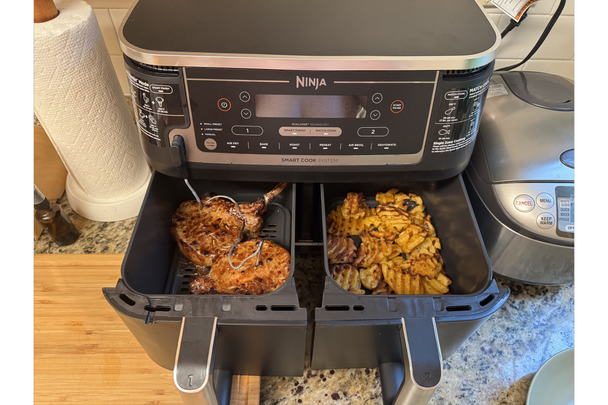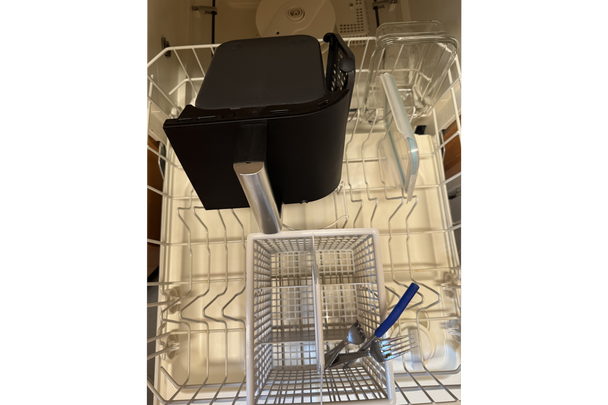Ninja foodi six-in-one smart 10qt two-basket air fryer
.png)
- Capacity: Two separate 5qt baskets
- Dimensions: L17.1-inch x W13.9-inch x H12.8-inch
- Weight: 19.8lb
- Temperature range: 105F-450F
- Wattage: 1,690W
- Why we love it
- Includes meat thermometer
- Dishwasher safe
- Low noise
- Simultaneously cooks two separate dishes
- Take note
- Not ideal for small spaces
- Pricey
- Modes have temperature restrictions
Design and setup
Compared to other basic air fryer models, the Ninja Foodi dual basket air fryer is a hefty machine. I won’t go so far as to write it off as an eyesore, because surprisingly, even with its enormous size, it doesn’t look that bad. Plus, its flat top surface doubles as a mini shelf for spices or random other knick knacks. And while I eventually came around to its size, it still takes up a lot of precious counter space. So I have to dock some points.
Its interface is fairly intuitive, although I would suggest checking in with its manual to really understand how to use all of its settings. Buttons for its special smart finish and match cook settings, along with its six cooking modes — air fry, bake, roast, reheat, air broil, and dehydrate — are prominently displayed front and center. You can manually control the temperature for each mode but there are restrictions. For example, the air fry setting doesn’t go below 300F. I understand this is for safety reasons, but it was frustrating when I wanted to hard-boil eggs at 270F.
On one side of the machine sits the meat thermometer probe (a great hidden feature), which I found to be a clever placement — hooray for machines that include built-in storage for additional tools. There’s a plug-in next to the left basket, where a meat dish is intended to cook if you’re looking to use the probe. The top of that particular basket has a small divet where the wire is supposed to go, so it doesn’t get crushed when it’s closed.
Additionally, the baskets have a capacity of 5qt, making a total of 10qt. They felt a bit small in comparison to my Cosori’s 6qt basket, but in the end, they were spacious enough for every dish I prepared. I generally did like that there were two separate baskets that both conveniently included crisper plates and a removable tray that allowed heat to circulate around food to create a crispy texture.
One feature that I missed from my Cosori was its “shake” timer, which allows you to program a basket to alert you when it’s time to flip or shake its contents for more even cooking. Of course, the simple solution for this is to set a separate timer for the Ninja foodi.
Cooking
Packed with six different cooking modes, the Ninja foodi could be an easy replacement oven for those living in a place without one. I personally favored the air fry and reheat modes, as I don’t often need to do much more than that, as I prefer to defer to my oven when possible.
To put the smart finish technology to the test, I cooked pork chops and fries. On the left side, I baked the pork chops, using the probe thermometer to alert me when they hit the desired medium-well-done temperature I was looking for. (I followed the manual’s suggestion to reduce the temperature by 25 degrees when converting traditional oven recipes.) On the right side, I air-fried waffle-cut fries.

After programming both baskets at different temperatures and cook times, I let the machine do its thing. It started by cooking the pork chops. Then, when just 15 minutes remained on the clock, the fry side kicked in, so that both could finish at the same time.
Once the timer went off, the pork chops were perfectly cooked, but the fries needed a little more time, likely because there wasn’t enough room in the basket to cook them in a single layer. By the time dinner was served, everything tasted solid. The fries were nicely crispy, though slightly overdone in some spots. And the pork chops turned out a bit drier than they would’ve been if I had cooked them in the oven, but still flavorful.
This was definitely a trend I noticed whenever I cooked meat in the air fryer — it tended to lack that juice I usually get from oven or stovetop cooking. Though honestly, an air fryer would never be my first choice for cooking meat, anyway.
Its reheat setting was nifty and convenient when I needed to warm up a pesto chicken sandwich and didn’t want it getting soggy in the microwave. However, admittedly, I had no idea how long or at what temperature to set it, so it also came out a bit crispier than intended.
After cooking several more dishes, I started to realize that Ninja’s air fryer might be a bit more powerful than my Cosori. The temperatures and cook times that worked perfectly in the latter usually needed some tweaking to get right in the foodi. But with a little more time — and a few minor adjustments — this will become an indispensable kitchen companion.
Cleaning
This machine is one of the easiest things to clean. The baskets are made of a certain non-stick material that makes it quite easy for you to wash away any mess, either by hand or in the dishwasher.

After simpler recipes, I washed both baskets and crisper plates in the sink with warm water and soap. But when it came to cooking a more messy meal or when I felt it required deeper cleaning, I used the dishwasher, and it came out spotless.

.png)